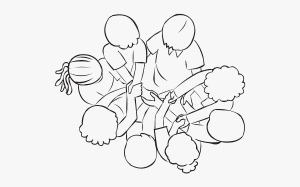Do you know how to plan a scavenger hunt? If not, you came to the right place. Imagine this: it’s a Sunday, outside it’s sunny and you want to do something fun and different with your friends or family. Of course, you heard of this interesting idea, but you don’t know where to start. Truth be told planning a scavenger hunt is not something everybody has a handle on, but worry not: this is why I’m here. I will teach you everything about scavenger hunts: from time and location to the list of items you have to gather to designing one yourself. Get your a piece of paper out and take notes, because if you do it right, this will be one fun experience for everybody involved.

What Is A Scavenger Hunt?
For the readers who don’t already know what a scavenger hunt is, this is for you. Simply put, a scavenger hunt is a competition taking place in an open and large space, where participants are given a list of objects that they have to obtain before the time is up. The hunt starts in one designated spot and from there everybody moves as fast as they can, solving riddles and finding the missing objects. The game can be played either in teams or individuals can be on their own. It is similar to a treasure hunt, the only difference being that there is no single treasure to be found, instead, there are multiple objects hidden in a variety of places.
Types of Scavenger Hunts
Planning a scavenger hunt is more about the steps you have to take in order to make it happen. First thing first, you need to decide what type of hunt you would like to organize. There are multiple choices, the theme depending on the place you want to organize it to the way you plan your hunt.
Neighborhood Scavenger Hunts
This is a great way to spend time with your friends and neighbors without having to go to a certain place. You can hide items all over the neighborhood or turn this into a door-to-door experience where players go from one house to the other asking for an item on their list.
City Streets Scavenger Hunts
If you don’t happen to live in the cozy suburbs or have the wide space of a decent neighborhood at your disposal, you can easily turn the city streets into your playground. You do have to practice some caution here, and not get too much in people’s way. But besides that, you are free to follow your plan. This version is better suited for young people or adults. All you have to do is choose your perimeter carefully and get on hunting.
Nature Scavenger Hunts
One of the most fun and engaging scavenger hunts out there are usually the ones that happen in the middle of nature. You can collect various objects that are part of the environment such as a specific type of tree leaf or a certain flower. If you are organizing the game for children this is also a great learning opportunity for them.
Stay-at-Home Scavenger Hunts
If you are stuck in the house, as most of us have been during the last years, you can easily customize the game and organize it indoors. You can use household items and scatter them around your apartment. This is a great way to break up a slow weekend and give the people around you an opportunity to have some fun at home.

How to Plan A Scavenger Hunt in 5 Easy Steps
1. Pick a place and an hour
First things first, you have to choose a location and a time during the day when you want the game to take place. You need to plan this accordingly, based on the people joining you. For instance, if the hunt is prepared for a group of adults or even teenagers, you might want to pick a more challenging place in order to make it fun for them. On the opposite side of things, if children are your main audience, then you might opt for a safer place like a park or a friendly neighborhood. Regarding the time, scavenger hunts can be held at any time during the day. You can also pick a later hour if you and your team are feeling a bit dauntless. And, as a tip, make sure you are aware of how the weather is during that day. You don’t want your hunt to be ruined by rain or anything like that. And if you can’t work around the weather, you can easily swap your outdoor area for an indoor place if you notice a storm coming your way.
2. Pick a distance
When you are planning a scavenger hunt, whether in the city, a neighborhood, or even a farm or forest, distance is a very important factor. You need to carefully draw some lines and be very clear about where the borders are within your chosen area. Otherwise, participants will most likely be unsuccessful in finding the objects on the list and pretty much get lost, especially if the place is very big. When picking a distance you must have a few things in mind such as: how many people will be attending, their age group ( will they be able to walk over a large distance? ), and most importantly, will the participants be able to cover the entire area in the given amount of time?
3. Pick a time
Picking a time is just as important as picking a distance. Actually, those two should be thought of together, since one will most definitely influence the other. Selecting the length of your scavenger hunt is also based on some factors such as: how much time it will take to cross the whole area, how much time are you willing to allocate to finding each item and how long do you think you can hold the participants’ attention. If you are working with children, for instance, it will prove to be a bit harder to keep their interest over a long period of time.
4. Choose the items
The key element of any scavenger hunt is the items you plan on hiding throughout the area. First of all, you need to create a list of all the objects you plan on acquiring for this activity. Of course, the type of scavenger hunt you do is as important. Whether it will be set in a forest or somewhere in the city, the items required will be different, so you need to take this into account as well. There are two basic paths that you can take when it comes to this step of the game. You can either collect yourself some items and place them in certain spots with clues leading to them, or you can simply generate a list of objects that are likely to be found in the area you are playing in, and make the participants acquire them. If the hunt will take place in a neighborhood and people will be going door-to-door, opt for less expensive items such as sheets of paper or pencils. If the hunt will be somewhere in nature, go for things that are naturally found in that specific environment. No matter the path you want to take, you need to make sure you compile a detailed lists of the items that need to be found, as well as the clues to retrieve them for the other players.
5. Design your hunt
Once all the steps above have been taken, the last thing you need to do is design your hunt. When you do that you need to take into account the people who are participating. What are their interest? Do they like puzzles, are they into riddles? The better you know them, the easier it will be for you to come up with various clues that will lead to the objects in question. You also need to plan the route, make sure you find a place to hide the items in and plant the clues along the way. A great thing to do, especially if you are doing this activity in a large public area, is to find some extra helpers to keep guard over the clues since there might be a chance someone else will bump into them. And, as a tip, you can always include some rewards at the end to make sure the players are extra involved in the game. Once all that is set you can start the game and watch as everybody will have the time of their lives.

Bottom Line
Planning a scavenger hunt is not as hard as you may think and the best thing about it is that it doesn’t require some special skills or any type of intense investment. They are pretty much inexpensive and they work great with most age groups. Not only that but they are proven to be easily customizable depending on your needs or creativity. You can make them as complex or as simple as you want them to be. You can have a complicated game in a large are with a big number of people, or you can go small and hold the game in your backyard. Either way the fun is guaranteed so don’t hesitate to give scavenger hunts a try.














